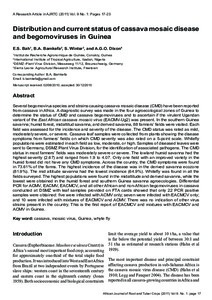| dc.contributor.author | Bah, E.S. |
| dc.contributor.author | Bamkefa, B.A. |
| dc.contributor.author | Winter, S. |
| dc.contributor.author | Dixon, Alfred G.O. |
| dc.date.accessioned | 2019-12-04T11:10:38Z |
| dc.date.available | 2019-12-04T11:10:38Z |
| dc.date.issued | 2011 |
| dc.identifier.citation | Bah, E.S., Bamkefa, B.A., Winter, S. & Dixon, A.G.O. (2011). Distribution and current status of cassava mosaic disease and begomoviruses in Guinea. African Journal of Root and Tuber Crops, 9(1), 17-23. |
| dc.identifier.issn | 1118-2075 |
| dc.identifier.uri | https://hdl.handle.net/20.500.12478/2215 |
| dc.description | RTB; Root and Tuber; Cassava |
| dc.description.abstract | Several begomovirus species and strains causing cassava mosaic disease (CMD) have been reported from cassava in Africa. A diagnostic survey was made in the four agroecological zones of Guinea to determine the status of CMD and cassava begomoviruses and to ascertain if the virulent Ugandan variant of the East African cassava mosaic virus (EACMV-Ug2) was present. In the southern Guinea savanna; humid forest, midaltitud savanna, and derived savanna, 88 farmers’ ields were visited. Each field was assessed for the incidence and severity of the disease. The CMD status was rated as mild, moderately severe, or severe. Cassava leaf samples were collected from plants showing the disease symptoms from farmers’ ields on which CMD severity was also rated on a 5-point scale. Whitely populations were estimated in each ield as low, moderate, or high. Samples of diseased leaves were sent to Germany, DSMZ Plant Virus Division, for the identiication of associated pathogens.The CMD status in most farmers’ fields was moderately severe or severe. The lowland humid savanna had the highest severity (2.67) and ranged from 1.9 to 4.07. Only one ield with an improved variety in the humid forest did not have any CMD symptoms. Across the country, the CMD symptoms were found in 73.61% of the farms. The highest incidence of the disease was in the derived savanna ecozone (81.9%). The mid altitude savanna had the lowest incidence (64.9%). Whitely was found in all the fields surveyed. The highest populations were found in the midaltitude and derived savanna, while the lowest were obtained in the humid forest and southern Guinea savanna agroecologies. Differential PCR for ACMV, EACMV, EACMCV, and all other African and non-African begomoviruses in cassava conducted at DSMZ with leaf samples provided on FTA cards showed that only 22 PCR positive samples were obtained: ive were infected with ACMV only; seven were infected with EACMCV only; and 10 were infected with mixtures of EACMCV and ACMV. There was no indication of other virus strains present in the country. This is the irst report of EACMCV and mixtures with EACMCV and ACMV in Guinea. |
| dc.language.iso | en |
| dc.subject | Cassava |
| dc.subject | Mosaic Viruses |
| dc.subject | Guinea |
| dc.subject | Whiteflies |
| dc.title | Distribution and current status of cassava mosaic disease and begomoviruses in Guinea |
| dc.type | Journal Article |
| dc.description.version | Peer Review |
| cg.contributor.affiliation | Institut de Recherche Agronomique de Guinée |
| cg.contributor.affiliation | International Institute of Tropical Agriculture |
| cg.contributor.affiliation | Deutsche Sammlung von Mikroorganismen und Zellkulturen |
| cg.contributor.affiliation | Sierra Leone Agricultural Research Institute |
| cg.coverage.region | Africa |
| cg.coverage.region | West Africa |
| cg.coverage.country | Nigeria |
| cg.coverage.country | Guinea |
| cg.identifier.url | http://istrc-ab.org/wp-content/uploads/2014/09/Journal-9edit41.pdf |
| cg.authorship.types | CGIAR and developing country institute |
| cg.iitasubject | Cassava |
| cg.iitasubject | Plant Diseases |
| cg.journal | African Journal of Root and Tuber Crops |
| cg.howpublished | Formally Published |
| cg.accessibilitystatus | Limited Access |
| local.dspaceid | 90946 |

